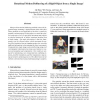Free Online Productivity Tools
i2Speak
i2Symbol
i2OCR
iTex2Img
iWeb2Print
iWeb2Shot
i2Type
iPdf2Split
iPdf2Merge
i2Bopomofo
i2Arabic
i2Style
i2Image
i2PDF
iLatex2Rtf
Sci2ools
ICCV
2007
IEEE
2007
IEEE
Rotational Motion Deblurring of a Rigid Object from a Single Image
Most previous motion deblurring methods restore the degraded image assuming a shift-invariant linear blur filter. These methods are not applicable if the blur is caused by spatially variant motions. In this paper, we model the physical properties of a 2-D rigid body movement and propose a practical framework to deblur rotational motions from a single image. Our main observation is that the transparency cue of a blurred object, which represents the motion blur formation from an imaging perspective, provides sufficient information in determining the object movements. Comparatively, single image motion deblurring using pixel color/gradient information has large uncertainties in motion representation and computation. Our results are produced by minimizing a new energy function combining rotation, possible translations, and the transparency map using an iterative optimizing process. The effectiveness of our method is demonstrated using challenging image examples.
Challenging Image Examples | Computer Vision | ICCV 2007 | Linear Blur Filter | Motion Blur Formation | Motion Representation | Single Image Motion |
| Added | 14 Oct 2009 |
| Updated | 14 Oct 2009 |
| Type | Conference |
| Year | 2007 |
| Where | ICCV |
| Authors | Qi Shan, Wei Xiong, Jiaya Jia |
Comments (0)

